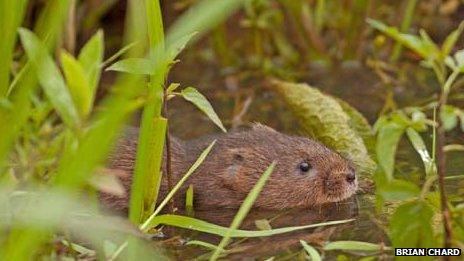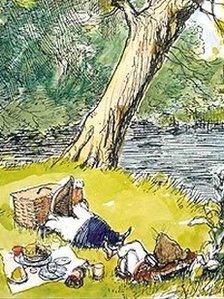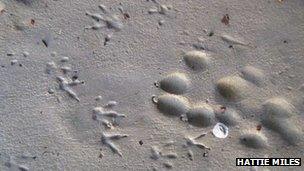Water voles back on the river in Dorset
- Published

Across the country the population of water voles has dropped from 1.2m to just 400,000 in 10 years
When 6,000 North American mink were set free by animal activists in Hampshire in 1998 the south's water vole population was decimated but the animal is making a comeback in one part of Dorset.
The endangered water vole - made famous through Kenneth Grahame's character Ratty in the Wind in the Willows - is being spotted again by visitors to the Moors Country Park thanks to a re-introduction programme.
"The water vole is Britain's fastest declining mammal," said senior countryside ranger, Matt Reeks. "And that decline has been caused principally by loss of habitat and predation by North American mink.
"For a successful re-introduction we needed not only to ensure they had a suitable immediate habitat - but we also had to monitor a wide area both inside and outside the park to make sure we were not bringing the water vole to a river system where they would quickly be eaten by mink."
Fur coats

The water vole is best known for The Wind in the Willows character Ratty
In the 1980s and 1990s thousands of North American mink were released into the British countryside from ranches set up to produce mink fur for coats and other clothing.
It meant the water vole - whose natural predators were animals such as foxes, badgers, stoats and weasels - had no defence against the mink which could out-swim them and were nimble enough to get into their burrows.
A recent report by the Environment Agency said the UK's water vole population has dropped 90% since the late 1980s, making it the UK's fastest declining mammal.
Numbers fell from 1.2m to just 400,000 in 10 years - while 8 million are estimated to have lived in Britain's waterways at the beginning of the 20th Century.
The team at the park near Ringwood in Hampshire took help and advice from water vole conservation specialist and breeder Derek Gow.
They were also helped with the idea for a so-called mink raft by the Game & Wildlife Conservation Trust.
Eleven rafts or platforms with a clay surface were placed up and down the Crane and Moors river system so rangers could collect information about the local mammal population by studying the animal footprints left in the clay.
After a year of regular monitoring they concluded that the area was mink free.
Mink has historically been spotted at the country park which lies near the border with Hampshire, however it is thought that otters may have pushed them out.
Over two years 320 water voles have been released into the waterways and now their star-shaped four-toed tracks are being spotted on the clay rafts.
'Once familiar presence'
Water vole specialist Mr Gow said the country park is the first in the south to re-establish a water vole population.

Now the star-shaped four-toed tracks of the water vole are being spotted on the clay rafts.
He said: "The project clearly demonstrates that water vole populations can be re-established where they have become extinct through a process of targeted mink control and solid community effort.
"The importance of the work at Moors Valley really cannot be overstated. Moors Valley is the first country park in the south to have taken this initiative, which is also the first re-introduction programme for Dorset.
"For the success of the water vole we need to instigate many more re-introduction projects just like this one.
"If that doesn't happen, the species will continue to decline throughout much of what remains of its former range and the water voles' once familiar presence in the British countryside will become nothing more than a memory."
- Published6 September 2012
- Published18 June 2010